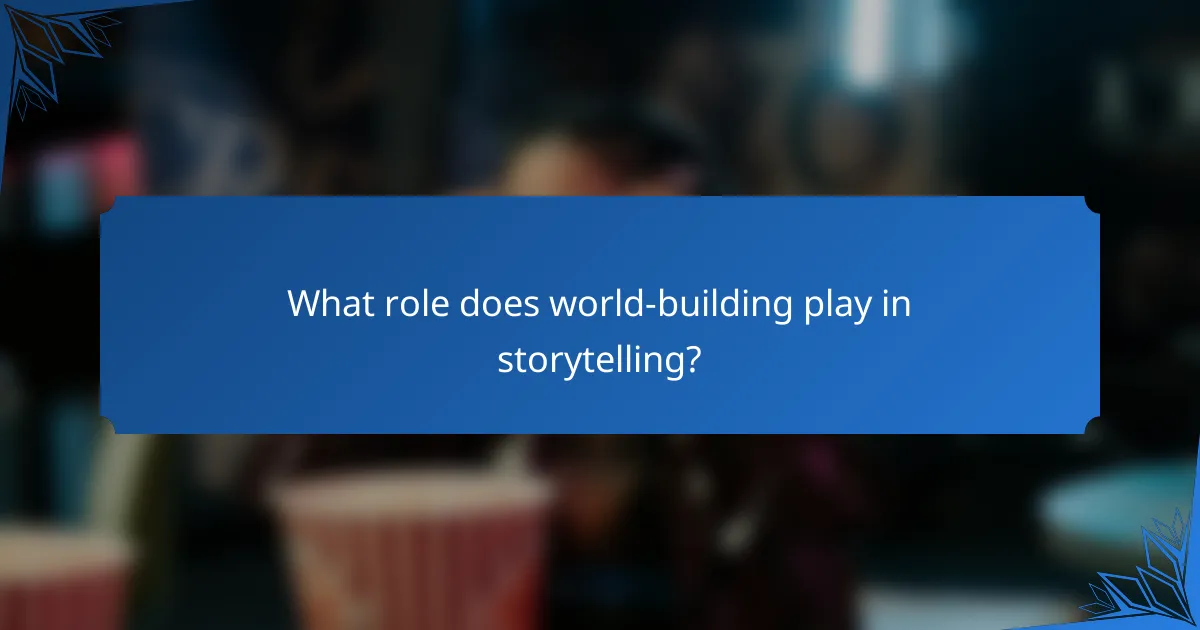Open world games utilize innovative storytelling techniques to craft immersive experiences that captivate players. By incorporating dynamic narratives, player-driven choices, and environmental storytelling, these games create a rich tapestry of interwoven stories that enhance engagement and personalization. The ability for players to influence story arcs and character fates adds depth to the gameplay, making each journey unique and impactful.

How do open world games utilize storytelling techniques?
Open world games leverage various storytelling techniques to create immersive experiences that engage players. These techniques include dynamic narrative structures, player-driven choices, and environmental storytelling, each contributing to a rich narrative landscape.
Dynamic narrative structures
Dynamic narrative structures in open world games allow for flexible storytelling that adapts to player actions. Unlike linear narratives, these structures can change based on decisions made throughout the game, providing a unique experience for each player.
For example, a player might choose to ally with different factions, leading to varying story outcomes and character interactions. This adaptability keeps the narrative fresh and encourages exploration, as players may want to see how different choices affect the story.
Player-driven choices
Player-driven choices are a hallmark of open world storytelling, empowering players to shape their own narratives. These choices can range from dialogue options to major plot decisions, allowing players to influence the direction and tone of the story.
Games like “The Witcher 3” showcase this by presenting moral dilemmas that affect the game world and character relationships. Players must weigh their options carefully, as their decisions can lead to vastly different endings or consequences.
Environmental storytelling
Environmental storytelling utilizes the game world itself to convey narrative elements without explicit dialogue or cutscenes. This technique involves using visual cues, item placements, and world design to tell stories and provide context.
For instance, a ruined village may hint at a past conflict, while scattered notes or artifacts can reveal character backstories. This method encourages players to engage with their surroundings, piecing together the narrative through exploration and observation.

What are the best examples of narrative techniques in open world games?
Some of the best examples of narrative techniques in open world games include immersive storytelling, character development, and player-driven choices. These techniques enhance player engagement and create a more personalized gaming experience.
The Witcher 3: Wild Hunt
The Witcher 3 masterfully combines a rich narrative with player choice, allowing decisions to significantly impact the story’s outcome. Players navigate a vast world filled with intricate quests that often feature moral dilemmas, leading to multiple endings based on their choices.
The game also employs well-developed characters, each with their own backstories and motivations. This depth encourages players to invest emotionally in the narrative, making their choices feel more meaningful.
Red Dead Redemption 2
Red Dead Redemption 2 excels in creating an immersive narrative through its detailed world and character interactions. The game features a dynamic story that unfolds based on player actions, with a focus on themes of loyalty, morality, and the consequences of choices.
Additionally, the game’s episodic structure allows for character development over time, enhancing emotional connections. Players experience the story through various perspectives, making the narrative feel alive and responsive to their actions.
Grand Theft Auto V
Grand Theft Auto V utilizes multiple protagonists to weave a complex narrative that explores themes of crime, ambition, and betrayal. Each character has unique story arcs that intersect, offering players different viewpoints and experiences within the same overarching plot.
The game also incorporates satirical elements and social commentary, engaging players with its humor and critique of modern society. This layered storytelling approach keeps players invested in the characters and their journeys throughout the expansive open world.

How do player choices impact narrative outcomes in open world games?
Player choices significantly shape narrative outcomes in open world games by allowing individuals to influence story arcs and character fates. These choices create a personalized experience, where decisions can lead to varying consequences that affect gameplay and story progression.
Branching storylines
Branching storylines are a hallmark of open world games, where players’ decisions lead to different narrative paths. For instance, choosing to ally with one faction over another can unlock unique quests and alter the game’s world state. This design encourages exploration and replayability, as players may want to experience all possible story branches.
Developers often implement branching storylines through dialogue options and quest decisions. Players should consider the long-term effects of their choices, as some may lead to unexpected alliances or rivalries that impact future gameplay.
Character development
Character development in open world games is heavily influenced by player choices, allowing for dynamic growth and change. Players can shape their characters’ personalities and skills based on decisions made throughout the game, such as choosing to be merciful or ruthless in interactions. This personalization enhances immersion and emotional investment in the narrative.
To maximize character development, players should engage with various NPCs and explore different dialogue options. This not only enriches the story but also can unlock unique abilities or storylines tied to character traits.
Multiple endings
Many open world games feature multiple endings, which are directly tied to the choices players make throughout their journey. Depending on the decisions taken, players might experience drastically different conclusions, ranging from heroic triumphs to tragic failures. This aspect adds depth and encourages players to reflect on their choices.
To achieve all possible endings, players should keep track of their major decisions and consider replaying the game to explore alternate outcomes. Engaging with different factions and completing various quests can reveal hidden endings that might not be accessible through a single playthrough.

What role does world-building play in storytelling?
World-building is essential in storytelling as it creates a rich backdrop that enhances narrative depth and player engagement. It involves constructing a detailed universe with its own rules, cultures, and histories, which helps to immerse players in the game’s story.
Creating immersive environments
Immersive environments are crafted through detailed landscapes, architecture, and atmospheric elements that reflect the game’s theme. For example, a post-apocalyptic world may feature crumbling buildings and overgrown nature, while a fantasy realm might showcase vibrant cities and mystical forests. These environments allow players to explore and interact, making the story feel more tangible.
To enhance immersion, developers should consider sensory details like soundscapes and weather effects, which can evoke emotions and reinforce the narrative. Using dynamic elements, such as changing day-night cycles, can further draw players into the world.
Historical context and lore
Historical context and lore provide depth to the world by explaining its origins, conflicts, and key events. This background can be revealed through in-game texts, dialogues, or environmental storytelling, allowing players to piece together the narrative as they explore. For instance, ancient ruins may hint at a once-great civilization, sparking curiosity about its downfall.
Effective lore should be coherent and relevant to the main story, avoiding excessive complexity that could confuse players. A well-structured timeline or a series of quests that uncover historical events can engage players and enhance their understanding of the world.
Character backstories
Character backstories enrich the narrative by providing motivations and personal histories that resonate with players. Each character’s past can influence their actions and relationships within the game, making them more relatable and compelling. For example, a character who lost their family in a war may seek revenge, driving the plot forward.
To develop strong backstories, consider integrating them into gameplay through dialogue choices or character interactions. This approach allows players to uncover layers of a character’s history, fostering emotional connections and investment in their journeys.

How do developers balance gameplay and narrative in open world games?
Developers balance gameplay and narrative in open world games by intertwining player freedom with structured storytelling. This involves crafting engaging quests that enhance the overarching narrative while ensuring that gameplay mechanics remain enjoyable and immersive.
Integrating quests with story arcs
Quests serve as the backbone of narrative in open world games, often designed to align with the main story arcs. By creating side quests that reflect or expand upon the main plot, developers can enrich the player’s experience and provide context for their actions. For instance, a side quest involving a character’s backstory can deepen emotional investment in the main storyline.
To effectively integrate quests with story arcs, developers should consider pacing and thematic relevance. Each quest should contribute to character development or plot progression, ensuring players feel their choices matter. A well-structured quest can also introduce new gameplay mechanics that enhance the overall experience.
Maintaining player engagement
Maintaining player engagement in open world games requires a balance of challenge and reward. Developers can achieve this by offering diverse activities, such as exploration, combat, and puzzle-solving, which keep players invested in the game world. Regular updates and expansions can also help sustain interest over time.
Another effective strategy is to implement dynamic events that respond to player actions, creating a sense of agency. For example, if players choose to ally with a particular faction, the game world may change in response, affecting quests and available resources. This adaptability fosters a more immersive experience.
Feedback loops between narrative and gameplay
Feedback loops between narrative and gameplay are crucial for creating a cohesive experience. When players’ actions influence the story, it reinforces their connection to the game world. Developers can implement branching storylines or consequences based on player choices, ensuring that gameplay decisions resonate within the narrative framework.
To establish effective feedback loops, developers should clearly communicate the impact of player choices. This can be done through visual cues, dialogue changes, or alterations in the game environment. By making the narrative responsive to gameplay, players are more likely to feel invested in both the story and their character’s journey.



